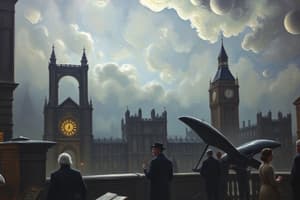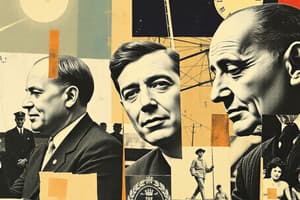Podcast
Questions and Answers
Which of the following would most likely have voted for Franklin Roosevelt during the Great Depression?
Which of the following would most likely have voted for Franklin Roosevelt during the Great Depression?
- Wealthy elites
- Middle-class Americans
- Working-class citizens
- All of the above (correct)
Why did many Americans move North during World War I and World War II?
Why did many Americans move North during World War I and World War II?
Northern factories held wartime job opportunities
Which of the following was part of Lyndon Johnson's War on Poverty and Great Society programs?
Which of the following was part of Lyndon Johnson's War on Poverty and Great Society programs?
- Medicare
- Head Start
- Food Stamps
- All of the above (correct)
How did Franklin Roosevelt's New Deal completely change American government?
How did Franklin Roosevelt's New Deal completely change American government?
Joseph McCarthy led a movement in the 1950's known as McCarthyism in order to expose _______.
Joseph McCarthy led a movement in the 1950's known as McCarthyism in order to expose _______.
Immigrants in America have traditionally been
Immigrants in America have traditionally been
Which of the following is an example of a vertical merger?
Which of the following is an example of a vertical merger?
Which of the following groups had their civil rights violated by losing all their property and being sent to internment camps during WWII?
Which of the following groups had their civil rights violated by losing all their property and being sent to internment camps during WWII?
Which of the following is an example of checks and balances?
Which of the following is an example of checks and balances?
The Supreme Court case Miranda v. Arizona protects your right to remain silent. Which Amendment of the United States Constitution does it support?
The Supreme Court case Miranda v. Arizona protects your right to remain silent. Which Amendment of the United States Constitution does it support?
Which of the following would best describe immigration laws after the Civil War and during the 1920's?
Which of the following would best describe immigration laws after the Civil War and during the 1920's?
Why was food rationing implemented during World War I and World War II?
Why was food rationing implemented during World War I and World War II?
The Civil Rights events in the 1950's, such as Brown v. Board, had the most impact on
The Civil Rights events in the 1950's, such as Brown v. Board, had the most impact on
The Voting Rights Act of 1965 had the most impact on
The Voting Rights Act of 1965 had the most impact on
What is the rust belt?
What is the rust belt?
What was the goal of American foreign policy after WWI and is demonstrated by the Neutrality Acts?
What was the goal of American foreign policy after WWI and is demonstrated by the Neutrality Acts?
The GI Bill and VA low interest home loans were created to reward veterans of
The GI Bill and VA low interest home loans were created to reward veterans of
Which of the following was an effect of Radical Reconstruction and the impeachment of Pres. Andrew Johnson?
Which of the following was an effect of Radical Reconstruction and the impeachment of Pres. Andrew Johnson?
The Interstate Commerce Commission helped _________ the most in the Gilded Age by regulating railroad and transportation prices.
The Interstate Commerce Commission helped _________ the most in the Gilded Age by regulating railroad and transportation prices.
What is the most important historical goal of unions in America?
What is the most important historical goal of unions in America?
Which of the following describes the presidency of Ronald Reagan?
Which of the following describes the presidency of Ronald Reagan?
Which of the following is an example of a simple majority?
Which of the following is an example of a simple majority?
The Sherman Act and Clayton Anti-trust acts were the first American laws to regulate _________.
The Sherman Act and Clayton Anti-trust acts were the first American laws to regulate _________.
Why was the 16th Amendment added to the United States Constitution?
Why was the 16th Amendment added to the United States Constitution?
Which of the following was a cause of the Great Depression?
Which of the following was a cause of the Great Depression?
The greatest source of jobs in impoverished areas of Appalachian America is ________.
The greatest source of jobs in impoverished areas of Appalachian America is ________.
What effect did post-Civil War expansion have on America?
What effect did post-Civil War expansion have on America?
American expansion into the Philippines, Hawaii, Alaska and Asia for new markets and resources is an example of
American expansion into the Philippines, Hawaii, Alaska and Asia for new markets and resources is an example of
What caused the dust bowl?
What caused the dust bowl?
What is the sun belt?
What is the sun belt?
What was the baby boom?
What was the baby boom?
Which of the following is an example of Civil Rights activity of the 1960's?
Which of the following is an example of Civil Rights activity of the 1960's?
Why did the Southern states develop cotton before the Civil War?
Why did the Southern states develop cotton before the Civil War?
Which of the following is a result of American expansion into the West?
Which of the following is a result of American expansion into the West?
Why did Woodrow Wilson win the election of 1912?
Why did Woodrow Wilson win the election of 1912?
How did the United States justify using atomic bombs against Japan in 1945 to end World War II?
How did the United States justify using atomic bombs against Japan in 1945 to end World War II?
Which of the following is a cause of WWI?
Which of the following is a cause of WWI?
What was the goal of the Marshall Plan, Truman Doctrine, NATO, Korean and Vietnam Wars during the Cold War?
What was the goal of the Marshall Plan, Truman Doctrine, NATO, Korean and Vietnam Wars during the Cold War?
Flashcards are hidden until you start studying
Study Notes
Franklin Roosevelt and the Great Depression
- Support for Roosevelt came from various socio-economic groups during the Great Depression.
- Implementation of the New Deal involved government deficit spending to tackle unemployment.
Migratory Patterns During Wars
- Many Americans moved North for job opportunities in wartime factories during WWI and WWII.
Civil Rights Movement
- Johnson's War on Poverty aimed to improve living conditions for marginalized groups.
- Japanese Americans faced civil rights violations during WWII through internment and property loss.
- Brown v. Board significantly impacted school integration in the 1950s.
Legislative Actions
- The Voting Rights Act of 1965 targeted voting discrimination, reinforcing electoral rights for marginalized individuals.
- The Senate's rejection of the Treaty of Versailles after WWI exemplifies checks and balances in action.
Supreme Court and Constitutional Protections
- Miranda v. Arizona established the right to remain silent, invoking the Fifth Amendment.
Immigration Trends and Laws
- Post-Civil War, immigration laws became more restrictive, limiting entry of non-Europeans.
- Immigrants historically faced discrimination and were often blamed for job competition.
Economic Policies and Union Goals
- Unions primarily aimed for higher wages and better working conditions for their members.
- The Sherman Act and Clayton Anti-Trust Act were foundational laws regulating monopolies.
Post-War and Economic Context
- The GI Bill provided benefits to WWII veterans, facilitating their reintegration into civilian life.
- Food rationing during both World Wars aimed to stabilize prices and avoid shortages.
Historical Developments and Regions
- The "Rust Belt" refers to areas in the Midwest and North with abandoned factories as industries shifted overseas.
- The "Sun Belt" indicates Southern states experiencing population growth since WWII.
- The "Baby Boom" marked a significant rise in birth rates post-WWII.
American Expansion and Foreign Policy
- American imperialism manifested in expansion into places like the Philippines and Hawaii for resources.
- The U.S. foreign policy after WWI focused on isolationism, reinforced by the Neutrality Acts.
- Post-Civil War expansion contributed to diminished freedoms for Native Americans, leading to their displacement.
Causes and Effects of Major Historical Events
- Causes of the Great Depression included various economic missteps and market failures.
- The Dust Bowl was primarily caused by soil erosion due to poor agricultural practices.
- The Marshall Plan and related Cold War strategies aimed to prevent the spread of communism.
Important Figures and Elections
- The 1912 election was won by Woodrow Wilson, aided by a split in the Republican vote.
- Joseph McCarthy's campaign aimed to identify and expose communists during the Red Scare of the 1950s.
Significant Historical Outcomes
- Radical Reconstruction led to a decrease in presidential power following Andrew Johnson's impeachment.
- Farmers benefited from the Interstate Commerce Commission's regulation of transportation prices during the Gilded Age.
Studying That Suits You
Use AI to generate personalized quizzes and flashcards to suit your learning preferences.




